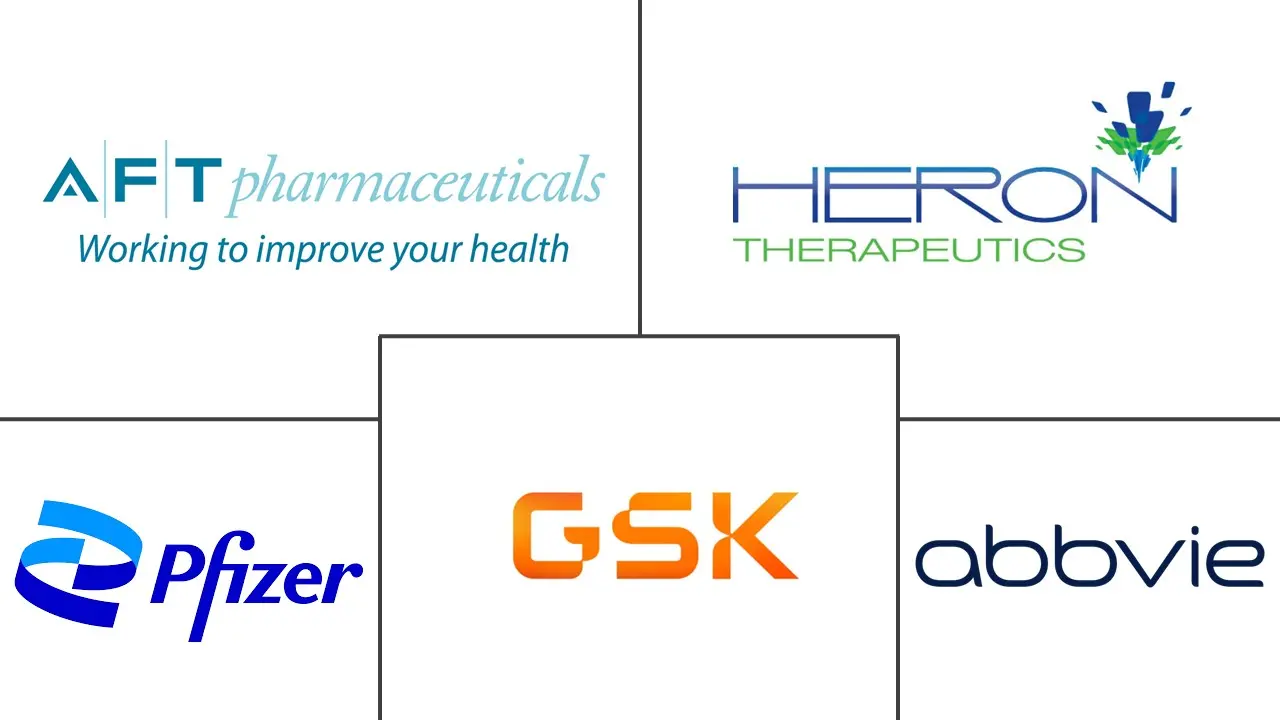Post-Operative Pain Management Market Size and Share
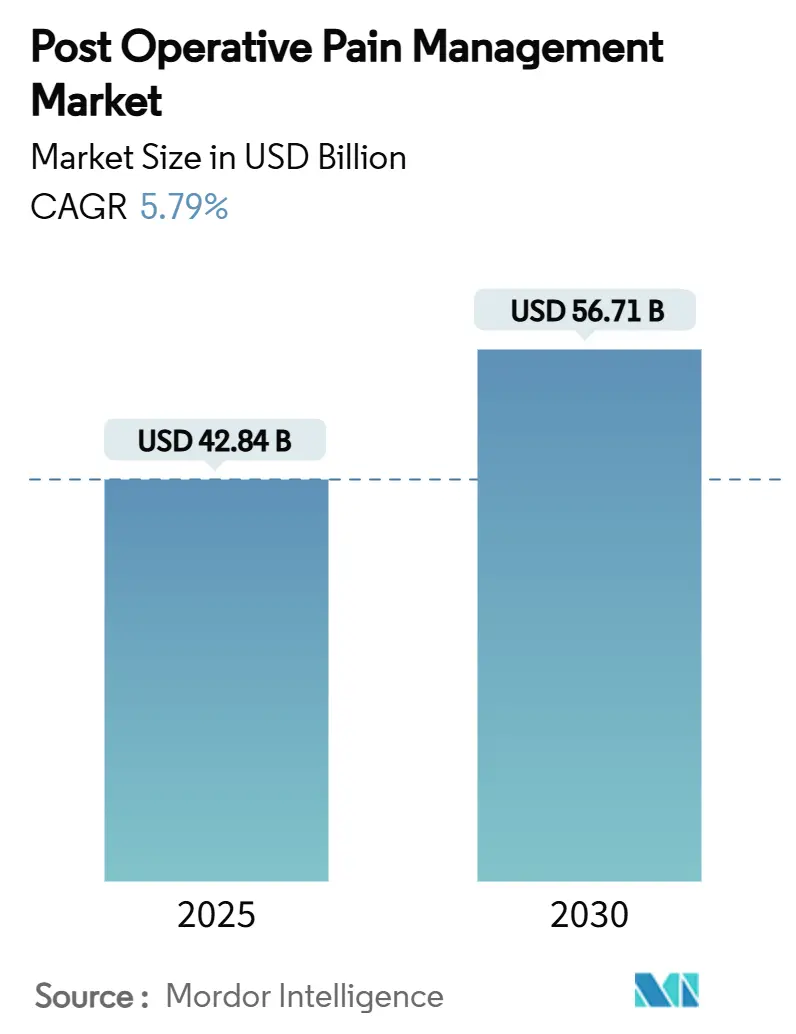
Post-Operative Pain Management Market Analysis by Mordor Intelligence
The Post Operative Pain Management Market size is estimated at USD 42.84 billion in 2025, and is expected to reach USD 56.71 billion by 2030, at a CAGR of 5.79% during the forecast period (2025-2030).
Steady adoption of multimodal analgesia, reimbursement incentives for non-opioid options, and long-acting regional techniques are accelerating demand across surgical specialties. Orthopedic, cardiovascular, and thoracic procedures anchor consumption, while Enhanced Recovery After Surgery (ERAS) protocols position local anesthetics and topical innovations for outsized growth. Cost-sensitive hospitals are trimming premium intravenous usage, yet AI-driven personalized dosing and digital pharmacy distribution continue to unlock efficiency gains. Competitive intensity is mounting as established pharmaceutical firms and biotech entrants vie to commercialize NaV1.8 inhibitors, extended-release nerve-block injectables, and smart transdermal systems.
Key Report Takeaways
- By drug class, opioids retained 42.18% of the post operative pain management market share in 2024, while local anesthetics are poised for an 8.27% CAGR to 2030.
- By route of administration, oral delivery commanded 56.63% of 2024 sales; topical and transdermal options are expanding at a 7.47% CAGR.
- By surgery type, orthopedic procedures generated 26.28% of 2024 revenue; cardiovascular and thoracic surgeries are on track for a 9.96% CAGR.
- By distribution channel, hospital pharmacies held 51.06% of 2024 turnover, whereas online pharmacies are growing at an 8.73% CAGR.
- By geography, North America led with 34.46% revenue share in 2024; Asia-Pacific is advancing at a 6.73% CAGR through 2030.
Global Post-Operative Pain Management Market Trends and Insights
Drivers Impact Analysis
| Driver | (~) % Impact on CAGR Forecast | Geographic Relevance | Impact Timeline |
|---|---|---|---|
| Growing Number of Surgical Procedures | +1.2% | Global, with concentration in North America & Asia-Pacific | Medium term (2-4 years) |
| Shift Toward Multimodal & Non-Opioid Protocols | +1.5% | North America & EU, expanding to APAC | Short term (≤ 2 years) |
| Adoption of Long-Acting Regional/Nerve-Block Anesthetics | +0.8% | Global, led by developed markets | Medium term (2-4 years) |
| Expansion of Ambulatory Surgery Centers Creating Demand for Rapid-Recovery Analgesics | +0.9% | North America, emerging in Europe & APAC | Short term (≤ 2 years) |
| AI-Driven Personalized Dosing Within ERAS Pathways | +0.6% | North America & EU, pilot programs in APAC | Long term (≥ 4 years) |
| Legislative Incentives for Non-Opioid Analgesic Reimbursement | +0.7% | North America, expanding to EU | Medium term (2-4 years) |
| Source: Mordor Intelligence | |||
Growing Number of Surgical Procedures
Ambulatory surgery centers increased from 612 specialized pain-focused facilities in 2018 to more than 800 by 2023, signaling accelerating procedure volumes that heighten baseline demand for multimodal analgesia.[1]“Population Projections and Ambulatory Surgery Growth,” bmcgeriatr.biomedcentral.com Aging populations in developed economies fuel orthopedic and cardiovascular operations, driving consistent consumption of regional anesthetics and adjuvant agents. ERAS pathways have become mainstream, institutionalizing evidence-based protocols that reduce length of stay while safeguarding pain control. Regulatory guidance under United States Food and Drug Administration (FDA) labeling promotes standardized postoperative dosing, giving hospitals a clear compliance roadmap. As volumes rise, suppliers that streamline dosing complexity and inventory management stand to capture incremental share in the post operative pain management market.
Shift Toward Multimodal & Non-Opioid Protocols
January 2025 FDA approval of suzetrigine introduced the first NaV1.8 sodium-channel blocker class, delivering analgesia without opioid dependency risk.[2]“Suzetrigine Approval Letter,” fda.gov Clinical implementation demonstrates up to 50% opioid reduction while preserving equivalent Numeric Rating Scale scores, especially in joint replacement and thoracic resections. Reimbursement incentives under the NOPAIN Act bolster hospital adoption, and ultrasound-guided nerve blocks now complement pharmacologic regimens in routine practice. The changeover requires protocol re-training but yields fewer respiratory events, shorter recovery, and higher patient satisfaction, all driving measurable savings that enlarge the post operative pain management market.
Adoption of Long-Acting Regional/Nerve-Block Anesthetics
Liposomal bupivacaine formulations extend single-shot block duration past 72 hours, lowering total opioid milligram equivalents by roughly 40% in enhanced recovery thoracic pathways.[3]“Extended-Release Bupivacaine Outcomes,” jtcvs.org Motor-sparing blocks like pericapsular nerve group and erector spinae plane methods protect early ambulation, reducing fall risk in elderly cohorts. As ultrasound guidance technology becomes ubiquitous, block success rates climb and complication incidence declines. Next-generation depot injectables such as three-month Neural Ice are in late-stage investigation, promising to reshape nerve-block utilization across large-joint and spine surgeries. Continued R&D momentum keeps regional anesthesia a primary growth vector within the post operative pain management market.
Expansion of Ambulatory Surgery Centers Creating Demand for Rapid-Recovery Analgesics
Outpatient surgical migration increases pressure for analgesics that control pain without sedation, nausea, or discharge delays. Same-day operative environments favor oral and topical formulations that minimize monitoring requirements and lower nursing workload. Cost-aware ASC administrators compare therapy options using average wholesale acquisition cost benchmarks, routinely selecting generic oral acetaminophen over high-priced IV analogs unless clinical contraindications exist. Patient-reported quality measures tied to pain management influence payer negotiations, further incentivizing facilities to deploy multimodal regimens with reliable, swift onset. This evolving care setting bolsters volume growth for companies aligned with the ASC segment of the post operative pain management market.
Restraints Impact Analysis
| Restraint | (~) % Impact on CAGR Forecast | Geographic Relevance | Impact Timeline |
|---|---|---|---|
| Opioid Addiction Crisis & Tightening Regulations | -0.8% | North America, expanding regulatory scrutiny globally | Short term (≤ 2 years) |
| Hospital Cost-Containment Curbing Premium IV Formulations | -0.7% | Global, most pronounced in cost-sensitive markets | Short term (≤ 2 years) |
| GI/Cardiovascular Risks of NSAIDs & Cox-2 Inhibitors | -0.5% | Global, with heightened awareness in developed markets | Medium term (2-4 years) |
| Patent Cliffs on Key Extended-Release Formulations | -0.4% | Global, affecting branded formulation markets | Medium term (2-4 years) |
| Source: Mordor Intelligence | |||
Opioid Addiction Crisis & Tightening Regulations
Prescription-drug monitoring programs and updated Centers for Medicare & Medicaid Services (CMS) guidelines limit postoperative opioid days’ supply, compounding administrative load for providers. Mandatory continuing-education curricula raise compliance costs and prompt conservative prescribing that may leave analgesic gaps in complex cases. While insurers increasingly cover non-opioid modalities, upfront acquisition prices remain higher, deterring broad adoption in smaller hospitals. The uncertain regulatory trajectory around opioid availability compels supply-chain contingencies, adding inventory expense. These factors collectively constrain near-term revenue expansion for opioid segments of the post operative pain management market.
Hospital Cost-Containment Curbing Premium IV Formulations
Formulary committees documented 83% reductions in intravenous acetaminophen usage, translating to annual savings above USD 400,000 within single health systems. Head-to-head trials show negligible clinical superiority over oral dosing for most procedures, eroding value propositions for premium IV presentations. Pharmacists limit access via computerized prescriber-order entry alerts, reserving IV formulations for strict nil-per-os or gastric-resection scenarios. Smaller facilities with tighter budgets adopt these stewardship models rapidly, depressing unit growth. Manufacturers must justify pricing through demonstrated outcome differentiation or shift portfolio focus toward extended-release local anesthetics and depot injectables to sustain their stake in the post operative pain management market.
Segment Analysis
By Drug Class: Local Anesthetics Sustain Highest Upside
Local anesthetics produced the fastest 8.27% CAGR outlook from 2025-2030, outpacing opioid, NSAID, and COX-2 categories. Liposomal bupivacaine’s broad labeling across orthopedic and abdominal surgeries showcases tangible opioid reductions and shortened length of stay. The post operative pain management market size for local anesthetics is expected to rise in lockstep with ERAS protocol penetration. Measured by revenue, opioids still commanded a 42.18% post operative pain management market share in 2024, yet the segment’s future is capped by prescribing limits and social scrutiny. The mid-spectrum NSAID class benefits from inclusion in nearly every multimodal pathway, though gastrointestinal warnings temper growth. Novel NaV1.8 inhibitors will enter the mix, potentially shifting share by 2027 when follow-on molecules gain approval. Regional anesthesia pipeline depth underlines sustained attention to non-systemic mechanisms, reinforcing local anesthetics’ strategic position.
Second-generation depot lidocaine and sustained-release ropivacaine implants may extend the category’s duration edge, while together with adjuvant gabapentinoids and alpha-2 agonists they deliver synergistic analgesia without additive toxicity. As payers examine total-cost-of-care metrics, formularies increasingly prefer long-acting local anesthetics that reduce inpatient opioid rescue meds and readmissions. This economic story aligns manufacturers and providers on continuous utilization increases, underpinning the rising revenue share forecast for local anesthetics within the broader post operative pain management market.
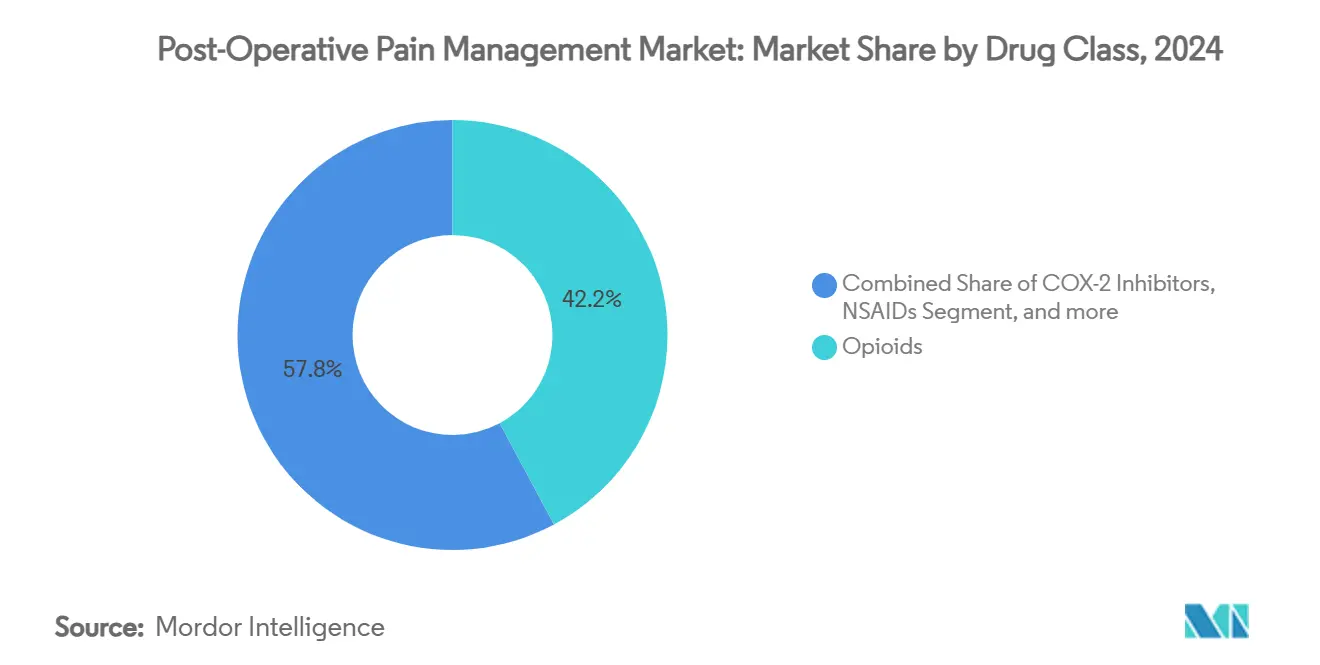
Note: Segment shares of all individual segments available upon report purchase
By Route of Administration: Topical & Transdermal Platforms Accelerate
Oral modalities retained 56.63% of 2024 sales, driven by established dosing familiarity and low per-unit cost. Microneedle and smart-patch advances, however, push topical market growth to a 7.47% CAGR through 2030, the fastest across all routes. Transdermal systems deliver consistent plasma levels, reduce nursing interventions, and support outpatient recovery, a pivotal advantage as surgeries shift to same-day settings. The post operative pain management market size tied to topical delivery should approach double-digit billion-dollar levels by 2030 if current adoption rates persist.
Injectables remain indispensable for immediate postoperative phases, especially in trauma and high- acuity cardiac cases requiring rapid onset. Yet hospitals’ focus on pharmacy spend prompts tighter criteria for IV orders in favor of oral equivalents when tolerated. Depot nerve-block injectables prolong analgesia for major joints and spine surgery, cutting demand for systemic medications. Technology collaborations pair wearables with transdermal patches that modulate release via smartphone apps, enhancing personalization and adherence. Such integrated solutions differentiate suppliers in the competitive post operative pain management market.
By Surgery Type: Cardiovascular & Thoracic Interventions Lead Growth
Orthopedic operations represented 26.28% of 2024 revenue, reflecting large volume of joint replacements and fracture repairs. Still, cardiovascular and thoracic surgeries show the most robust 9.96% CAGR projection, underpinned by ERAS cardiac programs emphasizing extubation within six hours and ambulation on postoperative day zero. These targets necessitate nerve-sparing blocks and non-opioid systemic agents that stabilize hemodynamics and respiration. The post operative pain management market share for cardio-thoracic segments is therefore set to widen despite lower procedure counts.
Abdominal and colorectal fields continue mainstream adoption of Alvimopan-aligned protocols that minimize ileus, integrating NSAIDs, epidural local anesthetics, and early feeding. Obstetric analgesia adds growth via expanded cesarean delivery volumes and maternal preference for breastfeeding-safe regimens. Eye, ENT, and robotic urology surgeries migrate to outpatient centers, creating micro-niche opportunities for rapid-offset formulations. Cross-specialty interplay keeps the overall post operative pain management market diversified and resilient.
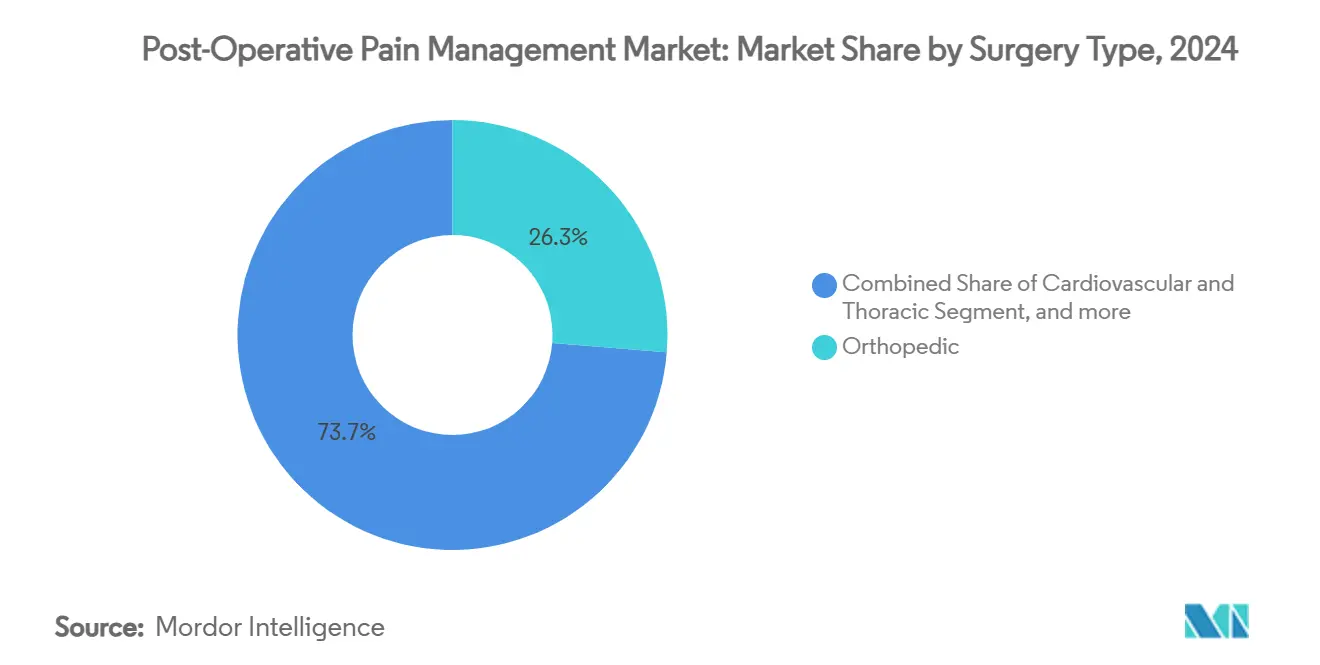
Note: Segment shares of all individual segments available upon report purchase
By Distribution Channel: Digital Health Reshapes Access
Hospital pharmacies generated 51.06% of 2024 turnover, a function of direct surgical linkage and centralized formulary power. However, online pharmacies, aided by e-prescribing and secure identity verification, are on course for an 8.73% CAGR to 2030. Smartphone refill reminders and same-day courier delivery support adherence, particularly for patients recovering at home after minimally invasive procedures. The post operative pain management market size attributable to digital channels is expected to double by 2029 under prevailing telehealth momentum.
Retail pharmacies occupy the midpoint, adapting by offering long-acting nerve-block kit pickup and pharmacist-led medication-therapy management sessions. Hospital-driven stewardship programs steer premium formulations to inpatient settings where monitoring is available while pushing generic oral options to ambulatory sites. Integrated analytics platforms share inventory and patient-outcome data across channels, elevating transparency and optimizing stock rotation. These interconnected systems position distribution stakeholders for synergistic growth in the post operative pain management market.
Geography Analysis
North America held 34.46% of global revenue in 2024 amid strong ERAS adoption, stringent opioid regulations, and reimbursement levers that favor non-opioid alternatives. FDA green-lights for NaV1.8 inhibitors and expanding ambulatory surgery center networks sustain demand, while payer scrutiny compels evidence-backed product selection. Health-system budgets topping USD 4 trillion ensure capacity for premium extended-release local anesthetics and AI-enabled dosing software, cementing the region’s leadership position.
Asia-Pacific is advancing at a 6.73% CAGR as surgical volumes climb in China, India, Japan, and South Korea. National insurance expansions and hospital-modernization drives bring ERAS pathways to secondary cities, stimulating uptake of multimodal regimens. Domestic manufacturers leverage cost-competitive generics while partnering with multinationals for depot formulations, thereby broadening product access. Regulatory harmonization across ASEAN accelerates registration timelines, further enlarging the post operative pain management market footprint in the region.
Europe posts steady growth tied to unified clinical guidelines and ongoing opioid-sparring directives from the European Medicines Agency. Topical and regional anesthetic innovations gain traction in Scandinavian and DACH countries renowned for early technology adoption. Middle East & Africa and South America remain emergent, yet Gulf Cooperation Council investments and Brazil’s public-sector procurements provide beachheads for premium analgesics. Collectively, these dynamics underline geographically balanced expansion potential for the post operative pain management market.
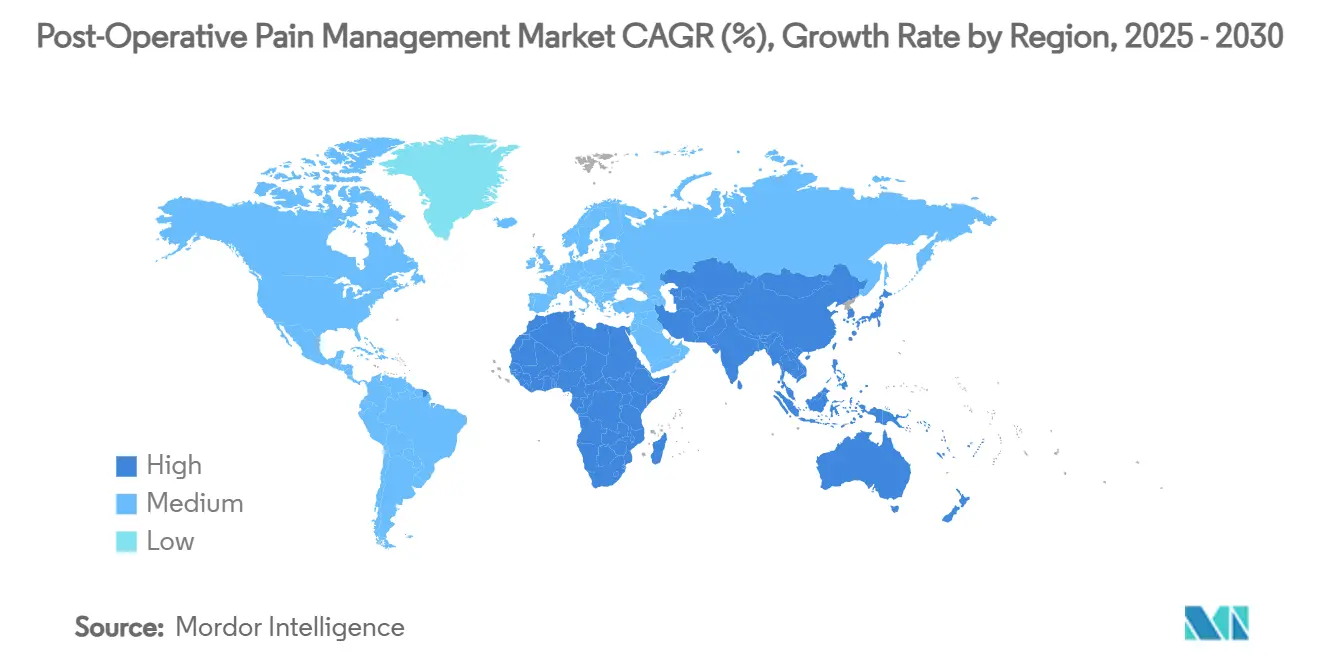
Competitive Landscape
The market exhibits moderate concentration as diversified multinationals compete with agile biotechs specializing in next-generation analgesics. Vertex Pharmaceuticals launched suzetrigine in 2025, capturing early NaV1.8 channel-blockade leadership. Pacira BioSciences defends share with EXPAREL’s sustained orthopedic and colorectal indications, while Eli Lilly’s USD 1 billion SiteOne Therapeutics acquisition signals escalating capital commitments to non-opioid platforms.
AI-software vendors integrate pharmacogenomics and electronic health record data to tailor dosing, partnering with device firms that deliver nerve-block catheters and smart patches. Portfolio breadth spanning oral, transdermal, and injectable modalities constitutes a key differentiator, enabling suppliers to address varying hospital budgets and surgery profiles. Patent cliffs loom for several extended-release opioids, inciting branded-generic maneuvers but simultaneously propelling innovators toward non-systemic pathways.
Strategic alliances emerge around depot lidocaine and ultralong-acting hydrogel carriers. Neuromodulation companies, including those offering spinal cord stimulation, position high-capital equipment as opioid-sparing alternatives for refractory postoperative pain. The competitive playing field therefore pivots on clinical-outcome evidence, procedural workflow integration, and payer economics—core levers that decide future winners in the post operative pain management market.
Post-Operative Pain Management Industry Leaders
-
AbbVie (Allergan)
-
Heron Therapeutics
-
Pfizer Inc.
-
AFT Pharmaceuticals
-
GSK plc.
- *Disclaimer: Major Players sorted in no particular order
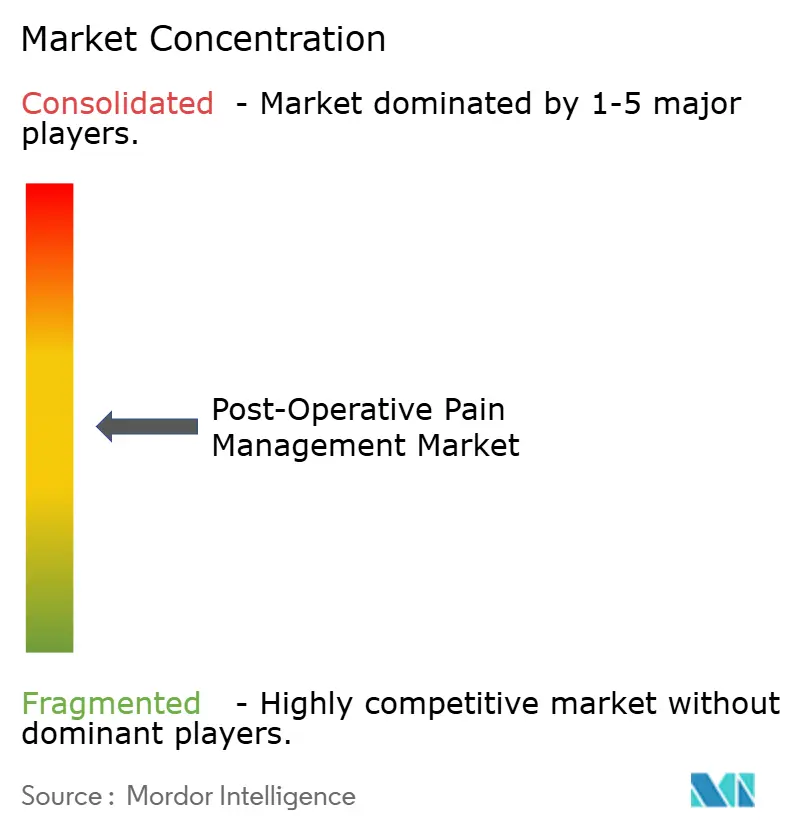


Recent Industry Developments
- May 2025: Eli Lilly announced a USD 1 billion acquisition commitment for SiteOne Therapeutics, targeting their NaV1.8 sodium channel inhibitor program to compete directly with Vertex's Journavx in the non-opioid pain management market. This strategic move represents the largest investment in post-operative pain management innovation and signals intensifying competition for next-generation analgesic technologies.
- April 2025: Ligand Pharmaceuticals subsidiary Pelthos Therapeutics merged with Channel Therapeutics to advance NaV1.7 programs targeting chronic pain, acute eye pain, and post-surgical nerve blocks. The combined entity will commercialize ZELSUVMI topical gel while developing innovative pain management solutions for unmet medical needs.
- April 2024: Forte Healthcare introduced Ficoxil, a flavored, chewable NSAID tailored to alleviate pain and inflammation in dogs, specifically targeting osteoarthritis and post-operative recovery.
- February 2024: Hikma Pharmaceuticals, a multinational pharmaceutical company, unveiled its latest product in the US market, COMBOGESIC IV, an injection combining acetaminophen and ibuprofen. COMBOGESIC IV is an intravenous pain relief medication devoid of opioids. It combines 1,000 mg of acetaminophen with 300 mg of ibuprofen, a non-steroidal anti-inflammatory drug (NSAID).
Global Post-Operative Pain Management Market Report Scope
As per the report's scope, post-operative pain is defined as a complex response to tissue trauma post-surgical procedures. It comprises both surgery-related pain and pain linked with central nervous system hypersensitivity. The purpose of post-operative pain management medications is to minimize adverse effects while reducing or eliminating pain and discomfort.
The post-operative pain management market is segmented by drug class, route of administration, distribution channel, and geography. By drug class, the market is segmented into opioids, non-steroidal anti-inflammatory drugs (NSAIDs), cyclooxygenase-2-selective inhibitors (COX-2) inhibitors, and other drug classes. By route of administration, the market is segmented into injectable, oral, topical, and other routes. By distribution channel, the market is segmented into hospital pharmacies, retail pharmacies, and other distribution channels. By geography, the market is segmented into North America, Europe, Asia-Pacific, the Middle East and Africa, and South America. The report offers the value (USD) for all the above segments. The report also covers the estimated market sizes and trends for 17 countries across major regions globally.
| Opioids |
| NSAIDs |
| COX-2 Inhibitors |
| Local Anesthetics |
| Adjuvant Analgesics |
| Injectable |
| Oral |
| Topical / Transdermal |
| Intrathecal / Epidural |
| Inhalational |
| Orthopedic |
| Cardiovascular & Thoracic |
| Abdominal & Gastrointestinal |
| Obstetrics & Gynecology |
| Ophthalmic & ENT |
| Others |
| Hospital Pharmacies |
| Retail Pharmacies |
| Online Pharmacies |
| North America | United States |
| Canada | |
| Mexico | |
| Europe | Germany |
| United Kingdom | |
| France | |
| Italy | |
| Spain | |
| Rest of Europe | |
| Asia-Pacific | China |
| Japan | |
| India | |
| Australia | |
| South Korea | |
| Rest of Asia-Pacific | |
| Middle East & Africa | GCC |
| South Africa | |
| Rest of Middle East & Africa | |
| South America | Brazil |
| Argentina | |
| Rest of South America |
| By Drug Class | Opioids | |
| NSAIDs | ||
| COX-2 Inhibitors | ||
| Local Anesthetics | ||
| Adjuvant Analgesics | ||
| By Route of Administration | Injectable | |
| Oral | ||
| Topical / Transdermal | ||
| Intrathecal / Epidural | ||
| Inhalational | ||
| By Surgery Type | Orthopedic | |
| Cardiovascular & Thoracic | ||
| Abdominal & Gastrointestinal | ||
| Obstetrics & Gynecology | ||
| Ophthalmic & ENT | ||
| Others | ||
| By Distribution Channel | Hospital Pharmacies | |
| Retail Pharmacies | ||
| Online Pharmacies | ||
| By Geography | North America | United States |
| Canada | ||
| Mexico | ||
| Europe | Germany | |
| United Kingdom | ||
| France | ||
| Italy | ||
| Spain | ||
| Rest of Europe | ||
| Asia-Pacific | China | |
| Japan | ||
| India | ||
| Australia | ||
| South Korea | ||
| Rest of Asia-Pacific | ||
| Middle East & Africa | GCC | |
| South Africa | ||
| Rest of Middle East & Africa | ||
| South America | Brazil | |
| Argentina | ||
| Rest of South America | ||


Key Questions Answered in the Report
What is the projected value of the post operative pain management space by 2030?
The post operative pain management market is forecast to reach USD 56.71 billion by 2030, up from USD 42.84 billion in 2025.
Which treatment class is growing fastest?
Local anesthetics are expected to post the quickest expansion at an 8.27% CAGR between 2025-2030, powered by extended-release nerve-block injectables and depot formulations.
Which geography will add the most incremental revenue?
Asia-Pacific is set to deliver the highest incremental gain, advancing at a 6.73% CAGR as surgical volumes surge and ERAS protocols spread across modernizing hospitals.
How are online pharmacies influencing postoperative care?
Online platforms are expanding at an 8.73% CAGR by pairing e-prescriptions with rapid delivery and adherence monitoring, improving access for patients recovering at home.
What innovation could disrupt nerve-block practice?
Investigational hydrogel injectables promising up to three months of analgesia from a single shot could significantly lower opioid rescue doses and redefine regional anesthesia workflows.
Why is suzetrigine important?
Suzetrigine inaugurates a new NaV1.8 inhibition class that delivers opioid-level pain relief without addiction risk, setting a new benchmark for acute postoperative therapies.
Page last updated on:
